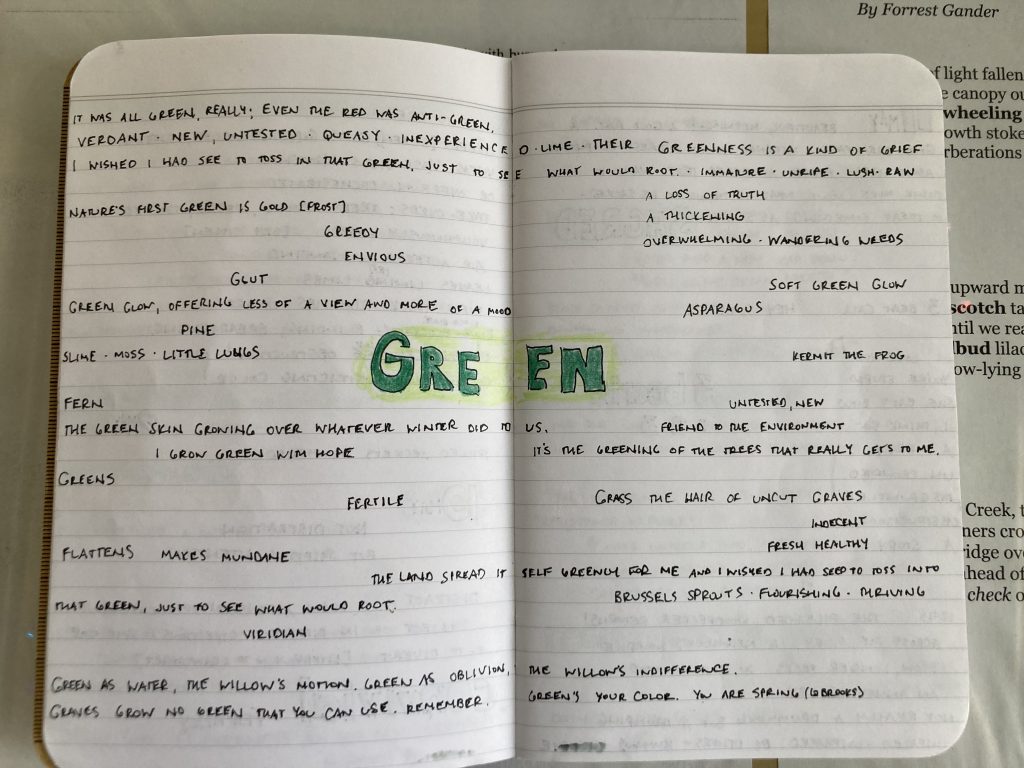5 miles
bottom of franklin hill and back
70 degrees / dew point: 60
Overcast, which helped it feel a little less warm. Sticky, thick air. A lot of sweat, especially on my face. Dripping ponytail. So green even the air was green. Greeted the Welcoming Oaks — hello friends! Descended into the tunnel of trees and was enveloped in green. Chanted triple trees: sycamore/sycamore/sycamore/red oak leaf/silver birch. Heard the rowers through the trees. Admired the barely moving, calm water under the bridge — the surface was dotted with foam and reflected clouds. Saw a speck in the sky out of the corner of my eye. Tried to look at it, gone. Tried again, a plane almost covered in fog. Saw a dark ring around it — my ring scotoma? Appreciated how the outline of the treetops on either side of the river road echoed the shape of the river banks. Walked up the hill — it took me 7 minutes — then ran, walked, ran back. Ended with a dozen roller skiers above me while I climbed out of the tunnel of trees.
For the first mile, in the dark green quiet, everything was dreamy. Thought again about how running puts me in a strange, surreal state. Nothing quite real. Then thought about Lorine Niedecker and the physical act of seeing with messed up eyes and using the poetic form to represent that. I’m not aware of how my eyes move as I see except for when I look to the peripheral as a way for my central vision to see something. I imagine having nystagmus makes you more easily register the movement of your eyes. How conscious was LN of her eye movement and how it was mimicked in her lines? When I think about how I see — the mechanics of it and its physicality — I think more about what happens when the corrupt or limited data travels as electrical impulses through the optic nerve and to the brain. Are the effects of nystagmus primarily physical — strain on eyes, the rapid movement creating dizziness and headaches? I should read more about it. . . . The physical impact of my vision sometimes reads as dizziness and light-headedness, but mostly it’s just a vague sense of unease and fatigue — more naps. I rarely feel the eye strain or get headaches from my effort.
In the article I was reading about LN’s nystagmatic poetics, this poem was discussed:
Tattoo/ Wallace Stevens
The light is like a spider.
It crawls over the water.
It crawls over the edges of the snow.
It crawls under your eyelids
And spreads its webs there—
Its two webs.
The webs of your eyes
Are fastened
To the flesh and bones of you
As to rafters or grass.
There are filaments of your eyes
On the surface of the water
And in the edges of the snow.
note at 11 am: Today is my first day of open swim! After the swim, I’ll return to this entry.
I’m spending the afternoon on the deck, reading Niedecker and thinking about Alice Oswald and Niedecker and my Haunts poems. Here are some jumbled thoughts:
You have been in my mind/between my toes/agate — Lake Superior/LN
You’ve been in
my mind
beneath my
feet Mom
Look for me under your boot-soles — Walt Whitman
Ars Poetica/ Arcelis Girmay
May the poems be
the little snail’s trail.
Everywhere I go,
every inch: quiet record
of the foot’s silver prayer.
I lived once.
Thank you.
I was here.
“We a lovely/finite parentage/mineral/vegetable/animal” — Wintergreen/ LN
I’m interested in how many layers you can excavate in personality. At the top it’s all quite named. But you go down through the animal and the vegetable and then you get to the mineral. At that level of concentration you can respond to the non-human by half turning into it.
Alice Oswald interview for Falling Awake
To write a poem is to be a maker. And to be a maker is to be down in the muck of making and not always to fly so high above the muck.
Poetry is Not a Project/ Dorothy Lasky
We can’t float or fly for long, above. We are part of the muck, not stuck but entangled, beholden
to work down/ to ocean’s black depths/us us an impulse tests/the unknown — Paean to Place/ LN
2 loops / 1.5 miles
lake nokomis open swim
80 degrees
Open swim! Open swim! I was nervous before the swim, wondering if I would see the buoys. I did! The water felt wonderful — a little cold, but not too cold, and wavy but not choppy. I watched the sun filtering through the water, avoided the vegetation growing up from the bottom and the swan boat stuck right by the orange buoy. That menacing swan was a little too close as I neared the buoy. The last green buoy was so far from the orange buoy — it seemed to take forever to reach the beginning of the loop. Oh, I love open swim and what joy to have had a good first swim!

